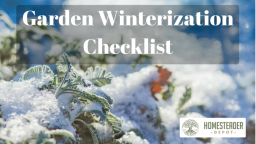As a homesteader, you may be wondering where you’re going to get the energy for preparing your garden for winter after all the hard work of harvesting the vegetables from your garden. Remember how happy you were when you realized that you wouldn’t need to buy any vegetables all winter long? Keep that in mind along with the fact that it will now be cooler to work outside.
You can print out the below list to check off items as you complete them and before long you’ll be done so you can take a break for a few days. Those gardeners in warmer southern areas can ignore the items not applicable.
Before Winter Check List
- Harvest any remaining root plants such as potatoes and carrots after their foliage has withered and died
- If you didn’t harvest all crops of specific vegetation such as winter squash, eggplant or cucumbers so you could collect their seeds, now is the time to pick before any frost
- Remove and discard all dead vegetation and rotten vegetables or fruit to keep away any pests that may cling to them for the winter
- Rake to remove small debris and to turn the soil
- Now is the best time to do a soil test for PH levels and minerals; adding a fertilizer such as fish and seaweed is excellent for adding minerals
- Be sure to have some covering handy for signs of the first frost and cover annuals as soon as there is a hint of frost on the way
- Cut back dead leaves on perennials that can survive winter and rose bushes, cover with about 3 inches of mulch; fragile rose bushes need protective covering if in colder climate

- Water shrubs and evergreens before a freeze and mulch after freeze
- Root crops such as parsnips, arugula, or sprouting broccoli can be stored in the ground for the winter (overwintered) and depending on your USDA zone, will need the protection of heavy mulch, a thick layer of straw, tarp or row cover
- After the first frost, cut back and dig up perennial bulbs such as gladiolus that can’t survive colder climates, dust off and store in breathable container like a cardboard box in a cool, dry place; cover beds with evergreen boughs
- Repair raised box beds and make more boxes if needed
- Pruning of shrubs that bloom in the summer should be done after all leaves are gone and while dormant or in early spring; however, hydrangea types such as mopheads should be pruned in June
More Garden Tips
- If you haven’t started a garden notebook yet, this is an excellent time to make notes on how each plant did, what problems it may have had, and if any areas didn’t grow as well as others.
- To tell when to harvest potatoes, rub the skin and if it doesn’t scrub off quickly, it’s ready.
- To save time and wear on your back when pruning plants, use a pole pruner to remove stems down to the base of the plant.
Conclusion
Winterizing your garden is the best way to ensure it will come back next spring looking as good or better than it did this year. How much time preparing your garden for winter will take depends on how big your garden is, what type of plants you have, and if applicable, when the first frost usually comes and how cold it usually gets where you live.
No matter where you live or what type of garden you have, we want to wish you a Happy Homestead Winterizing!

